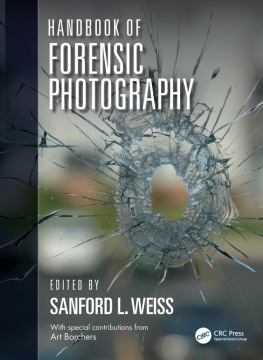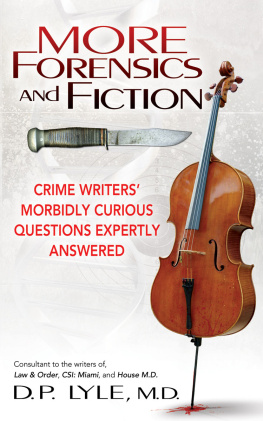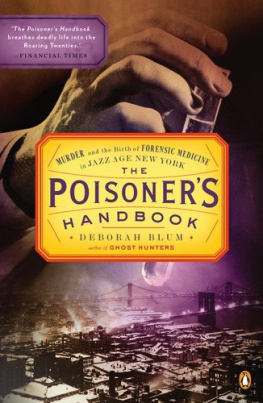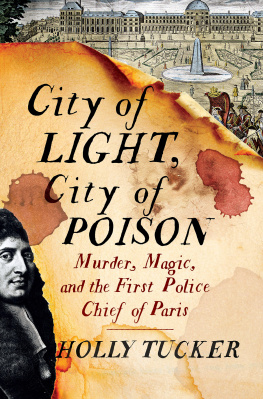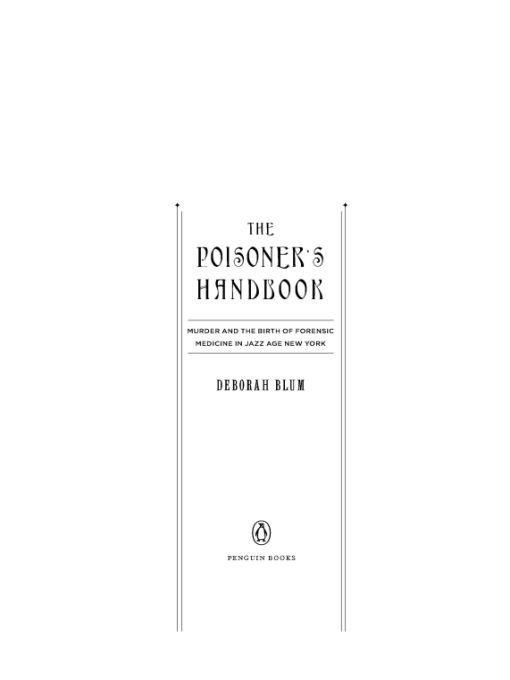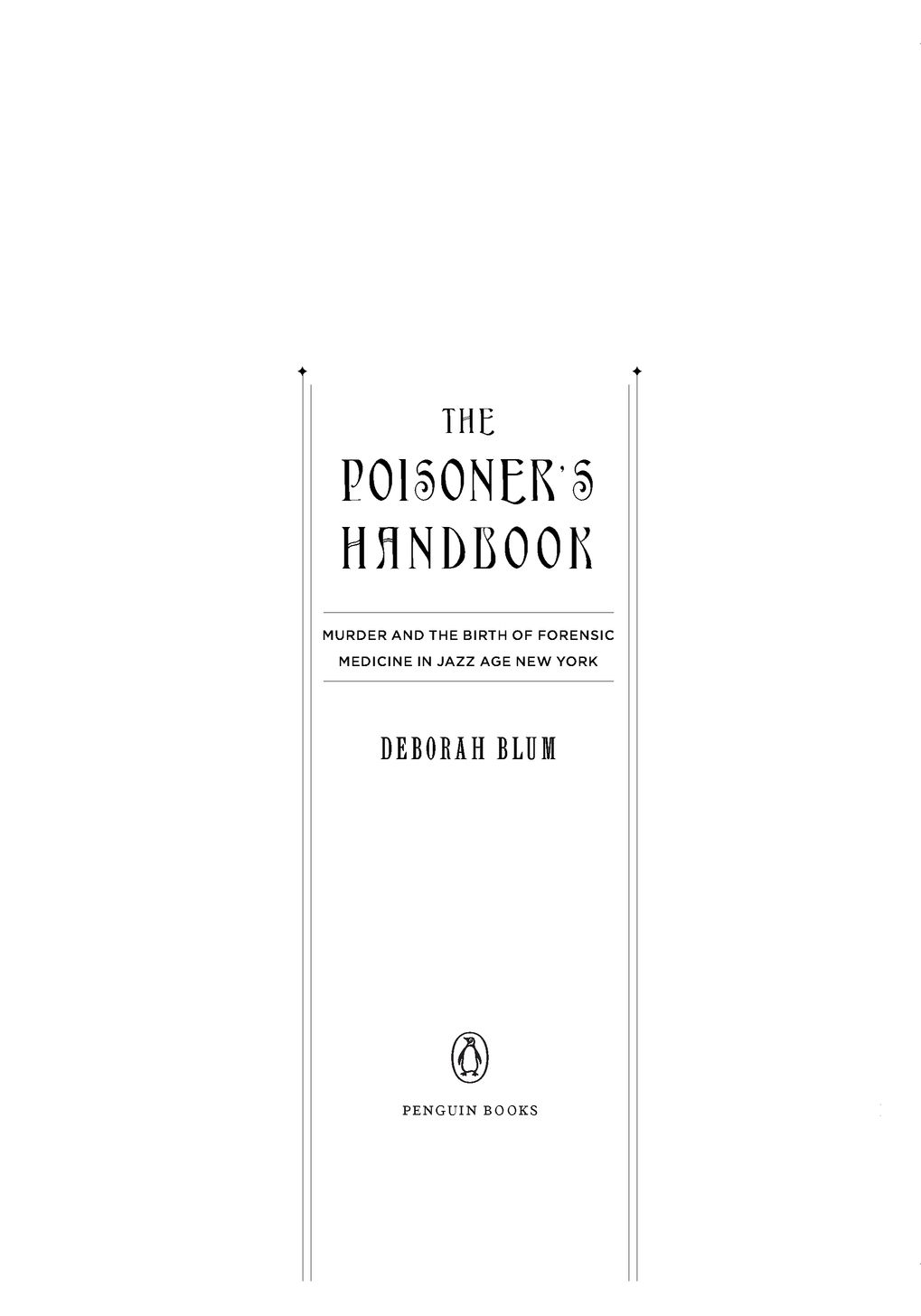Table of Contents
Praise for Deborah Blums The Poisoners Handbook
Blums combination of chemistry and crime fiction creates a vicious, page-turning story that reads more like Raymond Chandler than Madame Curie.
The New York Observer
Blums brilliant book is many things at once: a science lesson, peppered with historical anecdotes, tucked inside a compelling narrative that, in the end, is perfectly pitched and compulsively readable.
Milwaukee Journal Sentinel
Reads like science fiction, complete with suspense, mystery, and foolhardy guys in lab coats tipping test tubes of mysterious chemicals into their own mouths.
NPR, What Were Reading
One thinks of Erik Larsons Devil in the White City... a book that gave splendiferously disgusting descriptions of horrible murders and did it so dextrously and intelligently that even readers who wouldnt normally read a true crime book were happily sucked in. Deborah Blums The Poisoners Handbook: Murder and the Birth of Forensic Medicine in Jazz Age New York is that kind of book.
New Haven Advocate
The Poisoners Handbook is an inventive history that, like arsenic mixed into blackberry pie, goes down with ease.
The New York Times Book Review
Blums book is heavy on science, especially chemistry, but its also an excellent look at the lackluster state of public health in the Jazz Age.
Chuck Leddy, The Boston Globe
In this bubbling beaker of a book, [Blum] mixes up a heady potion of forensic toxicology, history, and true crime. Her account of the ongoing battle between scientists and killers in Jazz Age New York is more startling than any CSI: NY script.
The Dallas Morning News
The Poisoners Handbook is that rare nonfiction book that has something for everyone, whether you are a true-crime aficionado, a political history buff, a science geek, or simply a fan of well-written narrative suspense.
BookPage
Her book is sure to appeal to mystery lovers, science nerds, and history buffs drawn to a captivating story of two men whose skill and dedication helped transform the criminal justice system.
Associated Press
The pacing and rich characterization of a first-rate suspense novelist.
Publishers Weekly
Caviar for true crime fans and science buffs alike.
Kirkus Reviews
Blum has cooked up a delicious, addictive brew: murder, forensic toxicology, New York City in the twenties, the biochemistry of poison. I loved this book. I knocked it back in one go and now I want more!
Mary Roach, author of Packing for Mars: The Curious Science of Life in the Void, Bonk: The Curious Coupling of Science and Sex, and Stiff: The Curious Lives of Human Cadavers
The Poisoners Handbook opens one riveting murder case after another in this chronicle of Jazz Age chemical crimes where the real-life twists and turns are as startling as anything in fiction. Deborah Blum turns us all into forensic detectives by the end of this expertly written, dramatic page-turner that will transform the way you think about the power of science to threaten and save our lives.
Matthew Pearl, author of The Last Dickens and The Dante Club
The Poisoners Handbook is a wonderfully compelling hybrid of history and science built around eccentric characters. One scene reads like Patricia Cornwell and the next like Oliver Sacks. From movie stars and aristocrats to homicidal grandmothers and entrepreneurial gangsters, from the governments poisoning of alcohol during Prohibition to the dangers of radiation and automobile pollution, Blum follows an amazing array of poignant tragedies through the laboratory of these crusading public servants.
Michael Sims, author of Apollos Fire and Adams Navel
PENGUIN BOOKS
THE POISONERS HANDBOOK
Pulitzer Prize winner Deborah Blum is a professor of science journalism at the University of Wisconsin. She worked as a newspaper science writer for twenty years, winning the Pulitzer in 1992 for her writing about primate research. She is the author of Ghost Hunters, coeditor of A Field Guide for Science Writers, and has written about scientific research for the Los Angeles Times, The New York Times, The Wall Street Journal, Slate, Psychology Today, and Mother Jones. She is the president-elect of the National Association of Science Writers and serves on advisory boards for both the American Association for the Advancement of Science and the National Academy of Sciences.
To the Haugen familyDave, Helen, Peter (always),
Treakaand in loving memory of Pamela.
PROLOGUE
THEPOISONGAME
UNTIL THE EARLY NINETEENTH CENTURY few tools existed to detect a toxic substance in a corpse. Sometimes investigators deduced poison from the violent sickness that preceded death, or built a case by feeding animals a victims last meal, but more often than not poisoners walked free. As a result murder by poison flourished. It became so common in eliminating perceived difficulties, such as a wealthy parent who stayed alive too long, that the French nicknamed the metallic element arsenic poudre de succession, the inheritance powder.
The chemical revolution of the 1800s changed the relative ease of such killings. Scientists learned to isolate and identify the basic elements and the chemical compounds that define life on Earth, gradually building a catalog, The Periodic Table of the Elements. In 1804, the elements palladium, cerium, iridium, osmium, and rhodium were discovered; potassium and sodium were isolated in 1807; barium, calcium, magnesium, and strontium in 1808; chlorine in 1810. Once researchers understood individual elements they went on to study them in combination, examining how elements bonded to create exotic compounds and familiar substances, such as the sodium-chlorine combination that creates basic table salt (NaCl).
The pioneering scientists who worked in elemental chemistry werent thinking about poisons in particular. But others were. In 1814, in the midst of this blaze of discovery, the Spanish chemist Mathieu Orfila published a treatise on poisons and their detection, the first book of its kind. Orfila suspected that metallic poisons like arsenic might be the easiest to detect in the bodys tissues and pushed his research in that direction. By the late 1830s the first test for isolating arsenic had been developed. Within a decade more reliable tests had been devised and were being used successfully in criminal prosecutions.
But the very science that made it possible to identify the old poisons, like arsenic, also made available a lethal array of new ones. Morphine was isolated in 1804, the same year that palladium was discovered. In 1819 strychnine was extracted from the seeds of the Asian vomit button tree (Strychnos nux vomica). The lethal compound coniine was isolated from hemlock the same year. Chemists neatly extracted nicotine from tobacco leaves in 1828. Aconitinedescribed by one toxicologist as in its pure state, perhaps the most potent poison knownwas found in the beautifully flowering monkshood plant in 1832.





